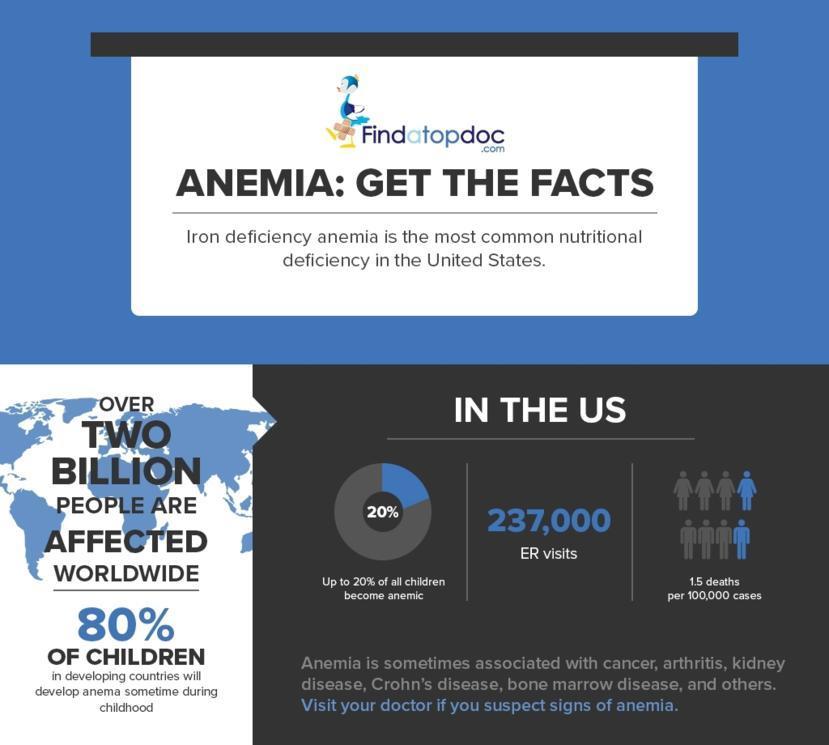5 Warning Signs that Indicate Anemia

Anaemia is a condition in which the amount of normal hemoglobin in the body is markedly reduced, or there is significant reduction in red blood cell count. The normal hemoglobin content in blood of males is 14-18g/dl (grams per metric decalitre of blood) and in females it is 12-16g/dl. It is not uncommon for infants to have a high count of hemoglobin in their blood, so don't worry too much if this is the case for your child.
During anemia the hemoglobin count is brought to very low values. As a result there will be a drastically reduced oxygen supply to the tissues of the body, leading to necrosis. There are a variety of types of anemia that may affect people. An iron deficiency is the main culprit behind most cases of anemia. In these cases, red blood cells and hemoglobin become unable to transform oxygen to vital components of the body, and in turn cause the muscles to work irregularly. A certain type of anemia can also be caused by lead poisoning, however, this is increasingly uncommon as time goes on.
Anemia is a growing problem in the world today because of its expansion through inheritance and as a result of poor iron consumption and supply in the body over long periods of time. Patients suffering from anemia may experience extensive symptoms that can cause them problems in their daily lives. Though this is the case, many people often misread or ignore these signs, and remain undiagnosed until their anemia worsens. Anemia can be of different types. Some are caused by reduced production of red blood cells as in the case of aplastic anaemia. Some are caused by increased destruction of red blood cells as in hemolytic anemia. Some by excessive blood loss. Some by deficiency of certain vitamins or nutrients, as in the case of iron deficient anemia. Pernicious or megaloblastic anaemia may be caused by gene mutations as in case of sickle cell anemia. And sometimes blood transfusion defects and malaria can also lead to anemia. Because anemia can occur due to various reasons and there are different varieties of anemia, the symptoms often vary. However there are few basic symptoms or warning signs that will help us to determine whether a patient has anemia even before seeking a professional medical diagnosis or treatment. The following are some of the warning signs that patients with anemia may notice:
1) Fatigue of the Bones
It’s quite common to experience fatigue when the body performs excessive workouts or stressful days, but fatigue due to anemia differs from these situations. Anemics often seem to experience a feeling of "tired bones" throughout the day, even when they do not exercise. This is a major warning sign that shows a lack of iron in the body.
Pain in the joints is specifically noticed when a patient has sickle cell anemia.
Severe bone deformities are observed in thalassemia major, where there is increased risk of injury to bones.
2) Paleness of the Skin
Physical features may help diagnose anemia, even if a patient dismisses his or her fatigue or is unaware of the problem. Arguably the most reliable warning sign is paleness of the skin and eyes. The water line in the eyes of a healthy person with good iron consumption is white, while a yellow coloration of the water line can signify anemia. The skin bed under the nails and palms can also change colors in patients suffering from this condition. The paleness is mainly caused by the decrease in haemoglobin content of blood or by the decrease in red blood cell count during anemia.
The color and appearance of moucous membranes also undergo a great deal of change during severe anaemia. Glossitis is another important sign. The appearance of the tongue in iron deficiency anemia is usually diffuse, or patchy atrophy, with a burning sensation. The appearance of the tongue in vitamin B12 deficiency is fiery red and sore. In addition, nails and skin are often dry.
3) Periods of High Density and Irregularity
The uterine canal in women contains a substance known as uterine, that can cause heavy amounts of blood loss during periods and even delay the monthly menstrual cycle in anemic women. This is also a sign of iron deficiency in the body. Fibroids in uterus are also reason for prolonged menstrual periods and excessive blood loss which can in turn lead to anemia.
4) Prolonged Anxiety
It’s common for people to experience anxiety due to outside factors. For example, people may feel anxious in stressful situations such as a job interview or a blind date. However, when people become anxious for no apparent reason, they may be anemic. Racing heart and light headedness caused by low oxygen supply to tissues lead to anxiety. Lack of proper sleep during anemia also makes the person anxious and depressed. Psychiatrists usually ask the patients to take blood tests to rule out anemia as a cause of depression or anxiety because of this overlap of symptoms.
5) Inappropriate Cravings
Though cravings for different foods are often completely harmless and normal, patients suffering from anemia often experience these cravings on an extreme level. Anemics have been known to have incredibly strange cravings, even including a hunger for non-food objects such as ice, clay, or paper.
The condition is often called pica. Iron deficiency anemia is the type of anemia in which pica is usually observed.
Other important symptoms
In iron deficiency anemia, Restless Leg Syndrome is often observed. The patient will have a frequent tendency to move or shake his or her legs.
Jaundice is commonly observed in case of hemolytic anemia's there is increased destruction of RBC, bilirubin content of blood will increase.
Shortness of breath is common to almost all types of anemia.
Mental and physical growth retardation is observed in sickle cell anemia.
In severe iron deficiency anemia, spoon nails or koilonychia is observed. The nails have lost their convexity and have become flat or concave in shape. Cheilosis is also observed. Dysphasia can also occur in some cases.
Bounding pulse can also be considered a sign.
Experiencing these warning signs is often sufficient to conclude a diagnosis of anemia. However, anyone that suspects they may have anemia should consult their doctor immediately to further investigate their symptoms.
















